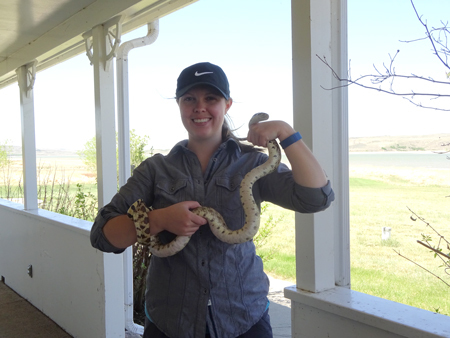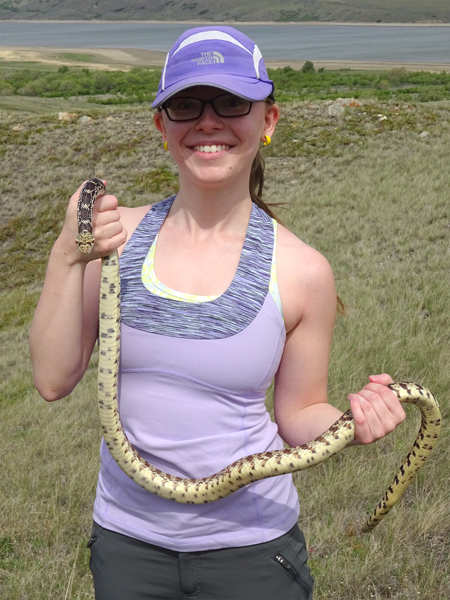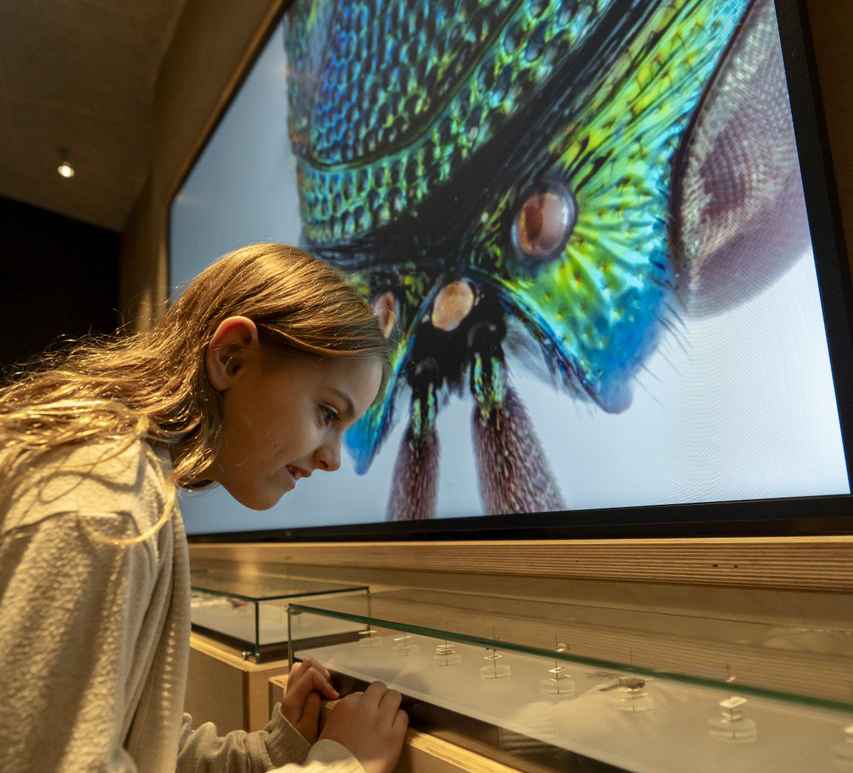Hello from Saskatchewan Landing Provincial Park!
I remember last summer I opened with something similar to this when we started our adventures in snaking in the Big Muddy Valley. But this summer we have expanded our adventures to Saskatchewan Landing Provincial Park. Even though we won’t get to spend the summer catching up with Magenta, Spike, Nagini, and the rest of the Big Muddy gang, we do get to meet a whole bunch of new bullsnakes.
So far this summer we have captured 16 different bullsnakes, 11 of which have been implanted with transmitters. We’ve found snakes all throughout the park: up in the hills, at the Goodwin house visitor’s center, in the campgrounds, on the hiking trails, and even at the beach! The park rangers and conservation officers have been a huge help in tackling the large area that is Saskatchewan Landing Provincial Park, even catching us a snake on a few occasions.

Here I am holding Drax, our first snake capture in Saskatchewan Landing Provincial Park
One of the reasons we’ve shifted our focus from the Big Muddy to Saskatchewan Landing is that we really want to explore how bullsnakes throughout the province use space in the three different river valleys where they’re found: the Big Muddy Valley, the Frenchman River Valley, and the South Saskatchewan River Valley. By the end of this summer I will be able to compare the movements and home ranges of bullsnakes across the province. So far this summer, I’ve found that snakes in Saskatchewan Landing don’t seem to be as large and, dare I say, fat as in the Big Muddy. We think this is because, on the farms in the Big Muddy, the snakes have plentiful meals of big, juicy ground squirrels. Snakes in Saskatchewan Landing, on the other hand, don’t have as many ground squirrels readily available to them, meaning that they have to find alternative food sources and have to work even harder to find food.
Saskatchewan Landing snakes also seem to poop A LOT when we hold them in captivity prior to taking them for surgery at the Western College of Veterinary Medicine in Saskatoon to implant their transmitters. This isn’t exactly relevant to our research, but it sure made an impression on Allie (my field assistant) and me, considering how much snake poop we’ve had to clean up. Especially when Soda-pop (one of our snakes) decided to cover himself in poop—it was lovely. (Soda-pop’s name comes from one of my favorite books: The Outsiders, and we also have a snake named Ponyboy!)

My field assistant for the summer, Allie, holding Ponyboy. Her love of snakes parallels mine, which makes her the ideal snake field assistant!
As World Snake Day approaches on July 16, I hope there are many of you out there, like me, that will be celebrating these extraordinary creatures. In many of the presentations Allie and I have done so far this summer to school groups at Saskatchewan Landing and at Native Prairie Appreciation Week at Cypress Hills, we’ve met many people who weren’t the biggest fans of snakes. However, after our presentation and having a chance to hold Clark (our education snake), people seem to warm up and even take a liking to them—which is the best outcome we could really hope for when we talk to people about snakes.
In my time studying snakes, I’ve found that there are two main reasons people don’t like them. The first is because people find them slimy and creepy—which isn’t true! Snakes aren’t slimy at all. Amphibians are the slimy ones, which we usually group together with reptiles (including snakes). If their leglessness is the issue, there’s not much I can do about that but if you do ever get the chance to touch or hold a snake, TAKE IT, you won’t regret it! In reality, snakes have scales that are dry and quite soft. It’s an experience that will help calm any fear or dislike of these legless reptilian friends.
The second main reason for snake dislike seems to be that some people perceive snakes to be aggressive and dangerous—the media’s portrayal of them being a factor. Movies have not helped with how people see snakes as they show snakes attacking people, giant snakes eating people, or even showing the mere appearance of a snake in a movie scene causing a stampede of people trying to escape. The movies always seem to just highlight how ‘dangerous’ snakes are. In reality, snakes are about as dangerous to us as any other animal in the wild. If you try to approach a wild bunny rabbit, it just runs away from you right? Snakes will do the same. They are scared of us because, to them, we are the threatening giants! I can’t wait until the day where there’s a movie scene with a snake in it that doesn’t include anyone screaming or running away, but someone simply keeping their cool and saying “Yup, that’s a snake, but no big deal!”

The first female bullsnake we captured this summer: Athena
Hopefully, I’ve enlightened you a bit with this blog entry about some of the common myths about snakes and why there really is no need to fear. I don’t expect everyone to love snakes as much as Allie or I, or celebrate World Snake Day with a cake (as we might be...). But I really hope that we can all learn to at least appreciate them as wildlife and important parts of Saskatchewan’s prairie ecosystem! So Happy World Snake Day everyone. May it be sssssssssuper duper great!

